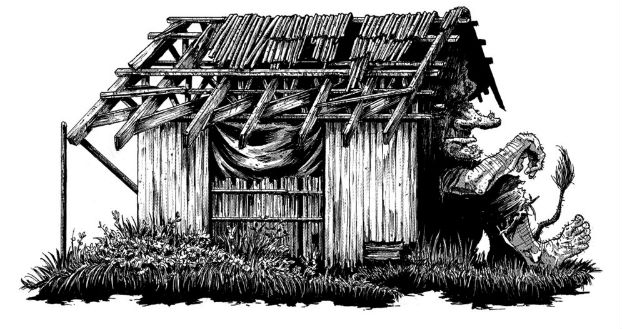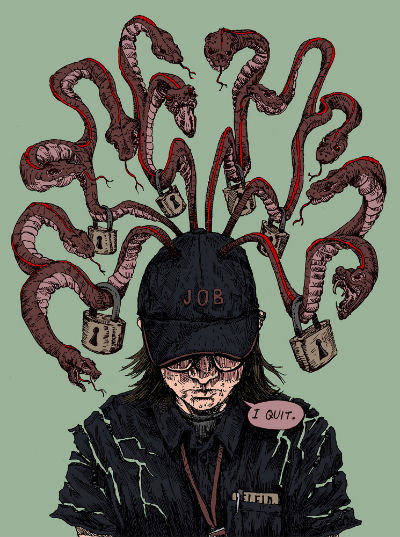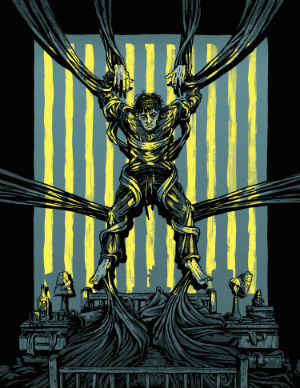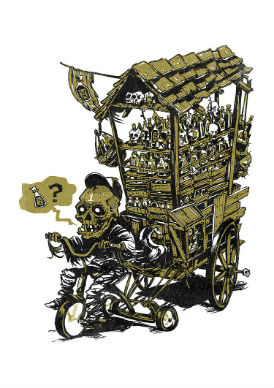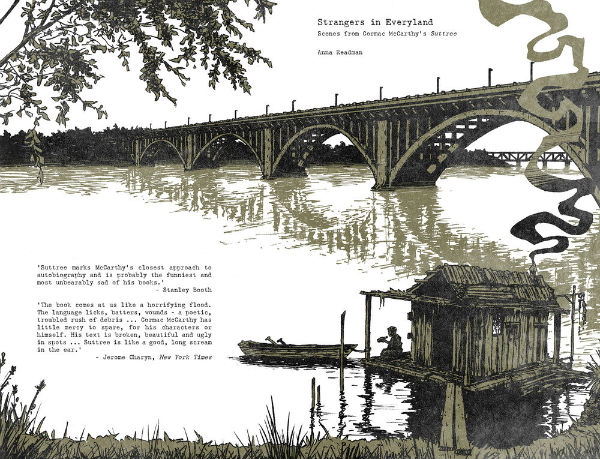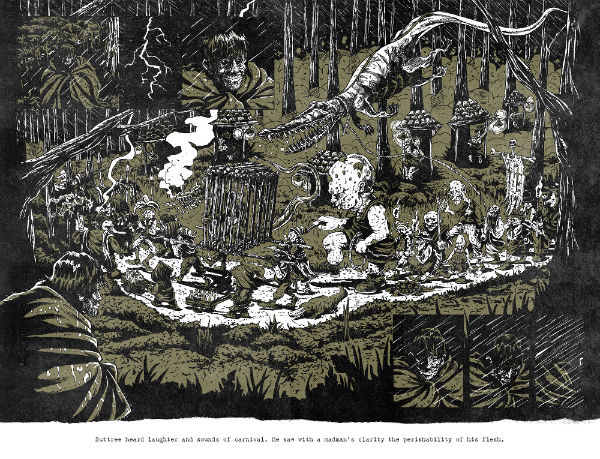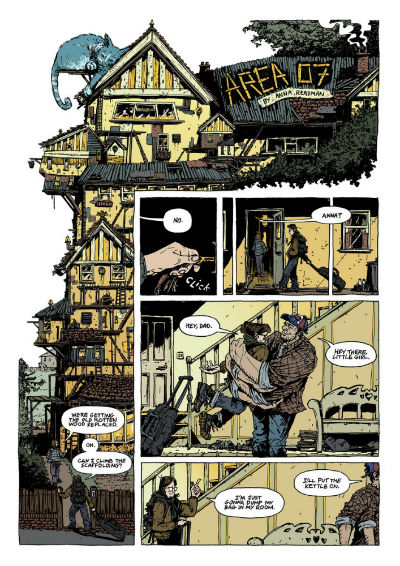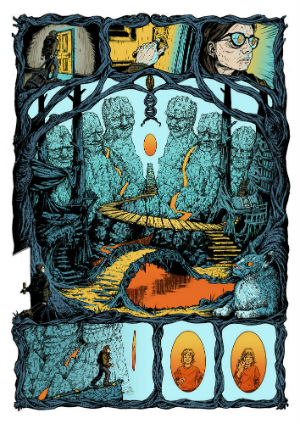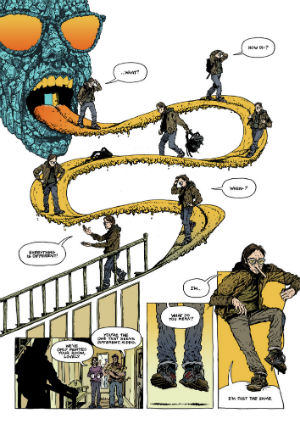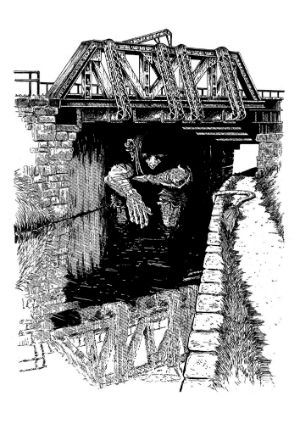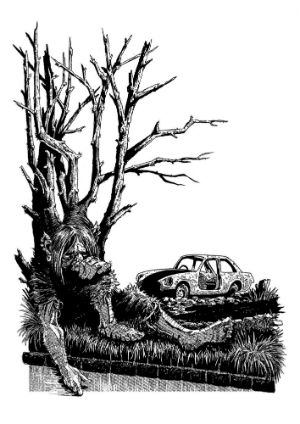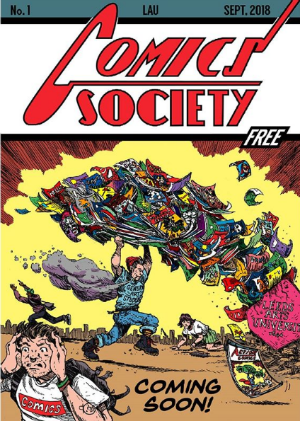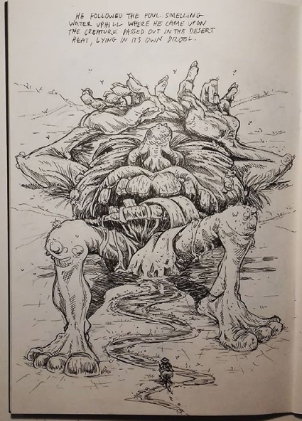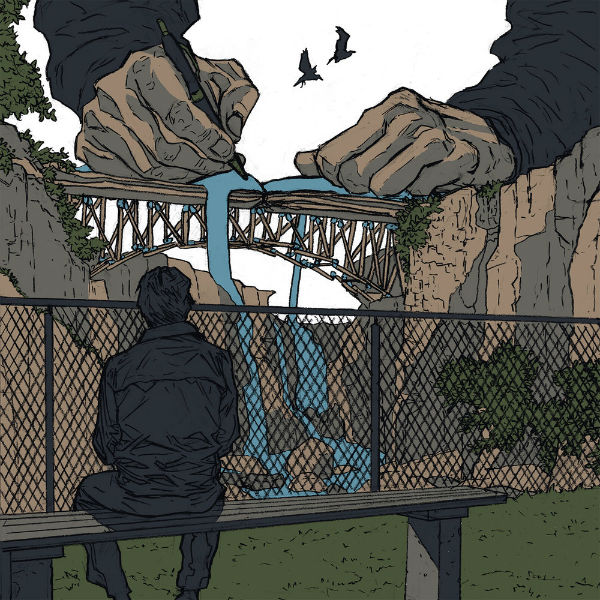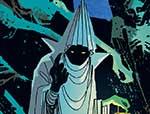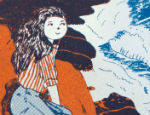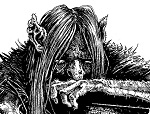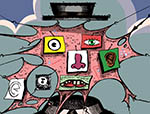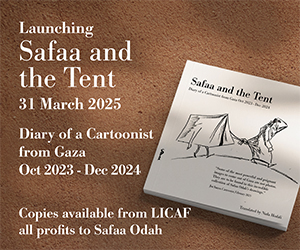With a surge of interest in her work on social media and a growing buzz about her online output it’s sometimes easy to forget that artist Anna Readman – one of this year’s Broken Frontier ‘Six Small Press Creators to Watch’ – has yet to publish comics in print.
Last month at BF I described Anna as “the future of British comics” in a review of her imaginatively metaphorical Area 07. This was no bombastic hyperbole. I firmly believe that over the next few years she’s going to prove to be a major new talent in the industry. In the meantime, though, she’s sensibly building the foundations for that future by concentrating on her studies and developing her creative voice.
I talk to Anna today about her inspirations, her explorations of the form’s possibilities and what we can expect to see from her in the very near future…
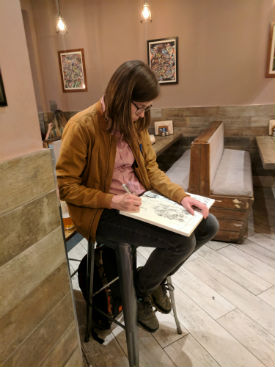 ANDY OLIVER: It only occurred to me when preparing this interview that you’re the youngest creator to be a part of our ‘Six to Watch’ initiative over the years! So to begin with could you give us some insights into your artistic background?
ANDY OLIVER: It only occurred to me when preparing this interview that you’re the youngest creator to be a part of our ‘Six to Watch’ initiative over the years! So to begin with could you give us some insights into your artistic background?
ANNA READMAN: Ha, I’m the same age as Tillie Walden and she’s already had five graphic novels out, so age seems to mean nothing these days – I’m slacking. I drew lot of comics as a kid. Tons of fearless comic-making, mostly Robin Hood or LotR rip-offs.
In secondary school there was a Comics Club run by this science technician, Daniel Bell, who is active in the British comics scene (you may recognise him as the artist on Defiant from Time Bomb Comics) Only three of us went to the club, but I learnt so much from Dan about drawing comics and he opened the world of small press and indie comics to 12-year-old me, which I will forever be grateful for.
I studied art as one of my GCSEs, did Graphic Design and Fine Art A-Levels then went on and did an Art Foundation. I’m currently in my second year studying Illustration at Leeds Arts University. They’re basically letting me do outside comic work as part of my degree now, which is very nice of them. Got to figure out how I can get out of doing my dissertation next.
AO: What was your entry point into comics?
READMAN: Watching the old 1960s Batman TV show and Batman: The Animated Series with my Dad from when I was around 4 years-old. I never read the classic British kids comics like the Beano or Dandy, it was always my Dad’s Calvin & Hobbes and Peanuts (he’s Canadian). The corner shop sold those Panini/Titan UK magazine Batman Legends which collected three stories every month, so I read that religiously. I used to go into my local library and just read their entire graphic novel section and wait until they would get new ones in. When I was old enough to travel into the city by myself (Brighton) I frequented Dave’s Comics. From there it’s just a blur of panels, speech balloons and spent pocket money.
AO: Your practice certainly has a darker feel to it, whether overtly or in the sense of an underlying tension to your narratives and illustration. Looking through your online portfolio both literature and film seem to be big influences on your work. Who and what would you count as your inspirations both inside and outside of comics?
READMAN: Yeah, I don’t know where all this dark stuff came from, I grew up watching The Waltons, so something must have gone wrong somewhere. I watched a ton of films in my late teens. Scorsese, PTA, Nolan, Fincher, Refn, Jonathan Glazer, Ben Wheatley, etc. David Lynch taught me that it’s wonderful to be weird and Werner Herzog taught me to be courageous in my artistic convictions. Philip Seymour Hoffman is my favourite actor and a big inspiration to me. In a Rolling Stone interview, he said: ‘Life is only as good as the day you do your work well’ and that’s sort of a personal motto of mine.
Literature wise, my parents are bookworms and I read lots as a kid. Anthony Horowitz, Charlie Higson, Lemony Snicket. My favourite authors now are Stephen King, Stieg Larsson and Cormac McCarthy.
Comics-wise, when I was 10 years-old I found Tales from the Farm by Jeff Lemire in an old bookshop in Canada and it was the first comic that made me realise I want to make comics as a proper adult job. When I was a bit older I really got into Hellblazer and through that discovered Sean Gordon Murphy who is still one of my favourite artists. I really love the art of Paul Pope, John Paul Leon, Jock, Sean Phillips, Jorge Fornes, Lee Bermejo, Chaboute. Right now, I’m trying to catch up on my comic art history and so for the past couple years have been reading Alberto Breccia, Jose Munoz, Sergio Toppi, Alex Toth, Jorge Zaffino, Hugo Pratt, Will Eisner. As you can tell, I really love B&W art, but also I love the weirder side of comics. Daniel Clowes, Robert Crumb, Patrice Killoffer and of course, Moebius, to name a few.
AO: What is it about the unique storytelling possibilities of comics as a form that ensured it was your medium of choice?
READMAN: I like the ownership with comics. Unlike film, comics only require a small team of creators to deliver the story. Or even just the one creator.
I like the control you have, and the lack of exposition and word vomit required to tell a story. Like Chaboute’s Park Bench – a perfect example of flawless silent storytelling. You control every aspect of time and space, manipulate the reader, piss-off the reader, make the reader sad, or happy. There is no limit to the genre, or indeed limited by genre. Only limited by what you can think of. Comics are anything you want them to be and hold the endless possibilities of the finest storytelling imaginable.
Reading a good comic is the best feeling in the world, and making your own comics is even better. I haven’t found anything close to it. Apart from maybe a good pint.
AO: The first of your comics that we reviewed at Broken Frontier was the Cormac McCarthy adaptation Strangers in Everyland. For those yet to read it can you tell us about the genesis of that project and how you approached bringing key elements of McCarthy’s novel to the comics page?
READMAN: It was a University project to create a set of works on a chosen author. I chose McCarthy and over last summer I read 6 of his novels, journal articles, analyses and forum threads to get a good understanding of his work as well as the contextual information and discourse surrounding it.
I chose to adapt Suttree as it is my favourite book of his, and the novel is almost like a large collection of little vignettes (nearly 600 pages), so structurally I could choose various scenes to be translated into sequential pages. McCarthy is known for his elaborate, often dream-like and surreal imagery – a mate described his work as ‘nightmare poetry’, and so I picked a lot of scenes with this type of language to be visualised in a graphic way. Suttree is also a very funny novel at times, and so I wanted a bit of humour and absurdity in there as well, just to balance out the depressing and anxious imagery.
The University brief was very focused on traditional print-making, and we were limited to two colours which is why there is a limited palette in Strangers in Everyland, and a lot of overplayed textures. This was also my first attempt at hand-lettering, which you can tell by how awful it is. I’m still practising. One day I want to be able to hand-letter as well as the French. One very, very far away day. [Read it online here]
AO: Your minicomic Area 07 – which merges slice-of-life storytelling with something altogether more fantastic – has seen a flood of new admirers for your work on social media. Why do you feel the subject matter of Area 07 lends itself so well to that level of fantasy metaphor?
READMAN: I made Area 07 [read it online here] to be entered for the Batsford Prize 2019, and the theme this year was ‘Being Human’. The rite of passage of moving out and finding your own feet in the world is one that is inherently human, but also distinctly odd. I tried to communicate this feeling through my own experience of coming home for Christmas this past year, and how my old home and childhood bedroom felt alien. I think one of the hardest things to really portray right in comics are emotions. Using visual metaphors and allegories, or even just simply making everything look surreal because everything feels surreal, is a lot easier to visually communicate said emotion than keeping it constrained to the rules of reality. It is easier to draw a complex emotion than to describe it, and there is no other medium that enables this intimate communication as well as comics does.
AO: Something I’ve enjoyed about your comics whether it’s the material on your site or work posted to Instagram is that there’s a meta element that creeps in sometimes. Is toying with the very structure of the form and its storytelling tools something that particularly interests you in your work?
READMAN: I think every element of the comics page and structure can be used to aid the storytelling, including the formal elements of the medium as well. There’s a great short TedX talk by Frank Quitely where he talks about this, it’s really worth the watch. However, I think playing with the meta aspects of comics needs to be done carefully and sparingly. If it is done too much, it’ll take you out of the story and turn into a gag (see Deadpool). If it serves or enhances the story, then I love to play with it, but if it only makes the reader acknowledge that it is just a comic and takes them out of the reading experience, then no. Kind of like how Christopher Nolan chose to make the Waynes see an opera instead of Zorro; Zorro reminds the viewer that there are other fictional movie vigilantes, thus taking them out of the immersion of watching the film as an original world. ‘The story is King. Everything else is slave to the story’.
AO: On the illustration side many readers may have seen images from your striking Forgotten Trolls zine online. What was the origin of that eye-catching collection?
READMAN: Again, it was just another Uni project. It was the last project of my first year and we had to create a picture book about an ‘Untold Story’. My Grandmother is Swedish and used to tell us tales about the trolls living in the forests where she grew up, and she was a fan of the artist John Bauer who illustrated a lot of traditional Swedish folk tales. I combined that with my cycling expeditions out west along the Leeds canal where there are a few abandoned buildings and bridges and created a narrative of these depressed trolls, where their old mythology is being forgotten. I’ve always been fascinated how environments and locations reflect emotional states and can even become characters in themselves, and so these old buildings and bridges portrayed the decay and abandonment of the trolls perfectly. It was also nice to combine where I was living with elements from where my Grandmother used to live. Merging the two worlds made me feel closer to her.
AO: Could we talk about your creative process now? What mediums do you work in? And given the detail and complexity of your art how long do you work on a page?
READMAN: I like working traditionally. So, bristol board, blue pencil for layouts, then inking I usually use some fine brush pens. Recently I’ve been enjoying those Tombow hard-tipped ones. Then I scan it all in and clean it up in Photoshop. I’ve started experimenting with colour as well, which is all done digitally too. Oh, and white-out. Lots of white-out.
I can normally pencil and ink a page a day. I am trying to anticipate working as if I was a professional with strict deadlines, so completing a page done a day seems to be the standard… I think. Not every page is completed within that timeframe, but I am still figuring out my line economy and ‘pictorial vocabulary’, as Scott McCloud would say. I tend to overwork a page so I’m trying to, as Alex Toth says, ‘strip it down to essentials and draw the hell out of what’s left’.
Anna’s work on university promo poster and from her sketchbook
AO: As an artist nearer the beginning of your comics journey what have been the biggest challenges in getting your work seen by larger audiences to date? Are there any words of wisdom you have for those contemplating self-publishing whether in print or online?
READMAN: I’ve never actively sought out large audiences for my work. I didn’t think my work was strong enough for me to start marketing it yet. But apparently, I just had Mad Sweeney’s coin and happened to be in the right place at the right time to have been noticed. Of course, I’m very grateful and appreciative for the people that engage with my stuff. The quantity always surprises me and the exposure from Broken Frontier and social media has been invaluable for my progression getting closer to the industry. I am thankful for it all. I’m just not that great with attention, so it’s a bit overwhelming. I’m just going to keep on posting my art so I don’t have to come up with funny tweets and put my personality online. That looks exhausting.
Words of wisdom… well, I don’t really have that much experience, so if anyone has any words of wisdom for me that would be great! I suppose what I have found so far is that authenticity and originality champions over aesthetic. Which is great, because I’ll never be the best draftswoman, but maybe I’ll have some edge somewhere else.
AO: Where can Broken Frontier readers look for you this year in terms of shows and events?
READMAN: I don’t really get out much to events, but I do go to Thought Bubble each year, just as a punter. So, I’ll be around in Lee… Harrogate in November. It’ll be my sixth time going this year.
I have yet delved into the world of print and selling my stuff at conventions and online. I need to make longer comics. That’ll be the next step. Printing and selling my own comics. Maybe prints and that too. Just need to make more stuff really.
AO: And, finally, what can you tell us about upcoming projects? Are there any teasers as to what else we might see from you in 2019 that you can share with us?
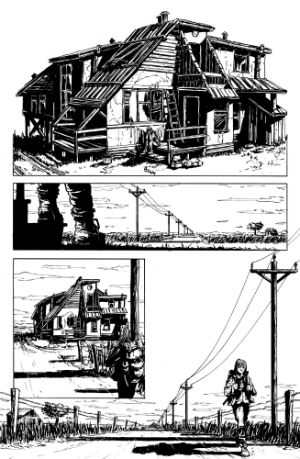 READMAN: I’m currently working on a comic with the fantastic Fraser Campbell called Indexed (sample art right). It’s a one-shot and the first sort of long-form comic I’ve done and so that’ll be a big thing this year. It’s a great script and story, and Fraser is amazing to work with and very open to my ideas and visualisation (and my lack of experience). So far it is going very well. Also, I’m doing a 4-pager with my friend Tony Vanraes for his upcoming anthology. So yeah, keep an eye out for those.
READMAN: I’m currently working on a comic with the fantastic Fraser Campbell called Indexed (sample art right). It’s a one-shot and the first sort of long-form comic I’ve done and so that’ll be a big thing this year. It’s a great script and story, and Fraser is amazing to work with and very open to my ideas and visualisation (and my lack of experience). So far it is going very well. Also, I’m doing a 4-pager with my friend Tony Vanraes for his upcoming anthology. So yeah, keep an eye out for those.
I’ve had a few amazing opportunities offered to me, and hopefully some of those will materialise over the next year(s?). Though, I’m still in my second year at Uni and so I sort of should prioritise that. It’s hard to find a balance with what I should do and what I need to do.
I think there is also an illusion that I have a lot of experience with making comics, but I really don’t, especially long-form stuff. So, I have a lot of learning to do to get to where I want to be. Not saying that I won’t get there, but I need to do my years on the beat and work my way up the ranks. That’s the plan anyhow. To be honest, I’ll just be happy if I can pay my rent doing comics stuff. Then I won’t have to get a real job.
For more on the work of Anna Readman visit her site here. You can download PDFs of Aher comics fromGumtree here.
You can also follow Anna on Twitter and Instagram.
For regular updates on all things small press follow Andy Oliver on Twitter here.
Interview by Andy Oliver





